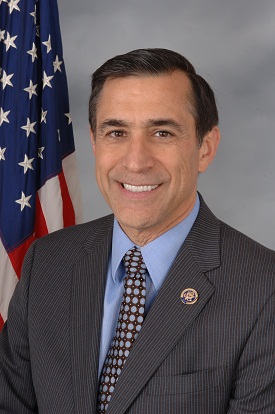
In the 1980s, millions of Americans bought personal computers.
In the 1990s, software companies like Microsoft and others developed tools that allowed those computers to go beyond the local network and connect to the internet, initiating an explosion of tech startups in my home state of California.
Today, many of the largest, most profitable, prolific, and innovative companies on the planet were born during that wave — like Google, Amazon and eBay. The initial tech wave has reverberated back with new startups creating products that revolutionize the way we communicate (Facebook, Twitter), watch TV (Netflix), or even hitch a ride (Uber).
But while the private sector caught the tech wave long ago, the federal government is still paddling after it. In a digital America, the federal government remains tragically analog, or even worse, paper-based.
For instance, despite a quarter of a billion dollars spent on an electronic claims processing system, retirement benefit applications for the vast federal workforce are still processed by paper because the software doesn’t work. Unable to design a handheld device that would allow enumerators to conduct their decennial door-to-door survey, the Census Bureau again sent tens of thousands of employees to the streets with pencils and paper.
…while the private sector caught the tech wave long ago, the federal government is still paddling after it. In a digital America, the federal government remains tragically analog, or even worse, paper-based.
Too often, when the federal government thinks about tech issues, they are too focused on regulating the choppy waters, and not on using tech to transform the way we do business.
When I was in the private sector in the ‘90s, I could track sales of my company’s products at stores across the country. Using software programs to analyze the sales patterns, if sales seemed low at a particular store, I could send a field rep out to make sure the product was displayed appropriately. Today, practically everyone with a credit card has received an “early fraud warning” automated call when your bank sees unusual activity on your account. This gives you the opportunity to halt purchases and prevent theft, or let them know you’re just on vacation so that’s why you’re buying gas two states over. Why can’t we use these technological tools for federal spending?
Because no one can truly “track” federal spending without hundreds of man-hours of work sorting through disjointed reports and databases. Even well-intentioned transparency efforts like USASpending.gov, created by legislation sponsored by Senator Tom Coburn and then-Senator Barack Obama, are hampered by the fact that agencies do not make complete, accurate, or timely reports.
One proposal to fix this is the Digital Accountability and Transparency Act (DATA Act). In essence, the DATA Act lays the blueprints for a truly open and digital government by organizing federal spending information and making it machine-readable. By developing a common “language” for data and making it available to download in bulk, journalists, academics, and citizen watchdogs will be able to build tools that ferret out fraudulent and wasteful spending and analyze the value taxpayers get for their dollar. Spending transparency is just a crucial first step: all federal data must be organized to make it more useful. If we do, the same big data analytic techniques that improve performance and save money on behalf of the shareholder today can be used on behalf of the taxpayer tomorrow.
Last year, the House of Representatives unanimously passed the DATA Act, the Senate introduced companion legislation, and the principles behind the bill were endorsed by Vice President Biden. This Congress I believe we will make the DATA Act law. But, in order to execute the blueprint for digital government, we must acquire the right tools.
To paraphrase President Reagan, the closest thing to eternal life on earth is a failing government IT project. Federal agencies spend 70-80% of their IT budgets maintaining outdated systems. Many of these systems are duplicative, and many are incompatible with one another. This not only wastes taxpayer money, it makes it harder to adapt the federal government’s software and hardware to changing needs.
To paraphrase President Reagan, the closest thing to eternal life on earth is a failing government IT project. Federal agencies spend 70-80% of their IT budgets maintaining outdated systems.
I am working on reforms that will help us buy IT smarter, consolidating authority and accountability in a smaller number of professionals, and encouraging cross-agency pooling of resources and expertise. The Technology CEO Council estimates that approximately $20 billion a year is wasted on bad IT purchases, and suggests nearly $1 trillion could be saved by 2020 with improved management technology.
While it is easy to focus on the government’s many issues adapting to technological innovation, many leaders in both parties already recognize that we do not have all the answers and are turning to technology to harness the wisdom of the American people. House Majority Leader Eric Cantor blazed a trail with the introduction ofYouCut in 2010, using social media to directly involve the American people in legislative scheduling. In 2011, the White House launched “We the People” on its official website, promising to answer every petition that reaches a threshold of signatures within 30 days. Even when that petition was encouraging the federal government to “begin construction of a Death Star by 2016,” the Administration took its promise to engage with the American people seriously, and answered the question with a creative yet still informative denial late last year.
I helped develop and launch an open-source legislative platform,Madison, in order to crowdsource an alternative to SOPA, an anti-piracy bill which would have literally shut down the internet and put compliance burdens on internet startups that would stifle the next dorm-room entrepreneur. Madison allows individuals to mark-up legislation, proposing their own amendments and commenting on other users changes.
Soon, this technology and others like it could truly transform the way Washington writes legislation. As California Lt. Governor Gavin Newsome mentions in his new book Citizenville: How to Take the Town Square Digital and Reinvent Government, “Behind the closed doors of Capitol Hill, lobbyists are constantly influencing and even drafting legislation— and you and I never know about it. But on the Project Madison site, anyone can see who is making the proposed changes. No secrets, no surprises. So why not extend this idea to other legislation as well?”
Change is never easy, but a paper-based and analog government cannot meet its citizens needs in a digital age. We need to retool our government not only to bring it up to speed with the private sector, but to make sure it can catch the next technological wave.
U.S. Representative Darrell Issa (CA-49) serves as Chairman of the House Committee on Oversight and Government Reform.




